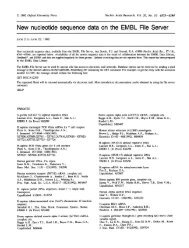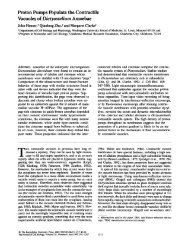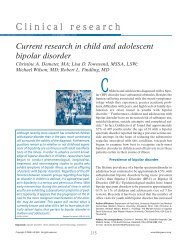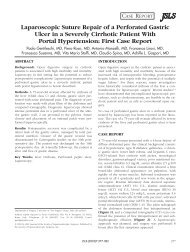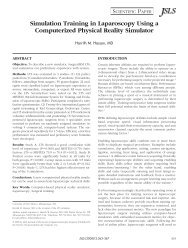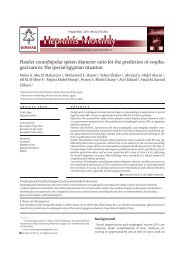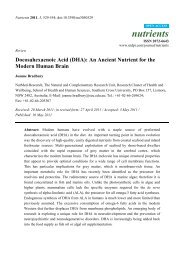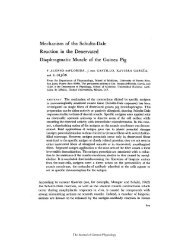Download PDF - BioMedSearch
Download PDF - BioMedSearch
Download PDF - BioMedSearch
Create successful ePaper yourself
Turn your PDF publications into a flip-book with our unique Google optimized e-Paper software.
with domains exposed to the intermembrane space. The matrix<br />
targeted protein, F 1b was not degraded by Proteinase K unless the<br />
inner membrane was also ruptured by the addition of detergent<br />
(Figure 4G). Slight changes in band intensity from lane to lane<br />
were not significant upon repetition, rather protease treatment<br />
drastically altered the levels of susceptible proteins such as after<br />
mitoplasting or treatment with detergent (Figure 4G).<br />
LncP Is a Nucleotide Carrier Protein<br />
Saccharomyces cerevisiae encodes 35 mitochondrial carrier<br />
proteins, including four proteins that can transport ATP:<br />
Aac1, Aac2, Aac3 and Sal1 [57] (Figure 5A). Yeast is a<br />
powerful model system to study cellular phenotypes, and<br />
fluorescence microscopy showed that ectopically expressed<br />
LncP is targeted to mitochondria in yeast (Figure 5B). Mutant<br />
yeast strains, each lacking one of these 35 carriers were<br />
transformed with a plasmid-based LncP expression construct<br />
and the transformed cells tested for growth complementation.<br />
The mutants were scored under conditions where characteristic<br />
A Mitochondrial Carrier Protein in Legionella<br />
Figure 2. LncP is translocated into macrophages by the Dot/Icm T4SS. (A) THP-1 macrophages were left uninfected or infected with<br />
derivatives of L. pneumophila 130b carrying the pEC34 vector or expressing the indicated Cya hybrid proteins. Following infection for 1 hour,<br />
macrophages were lysed and total intracellular cAMP was measure by ELISA. Results are expressed as fmol cAMP and are the mean 6 standard<br />
deviation of three independent experiments, each performed in duplicate. Note Cya-LncPDPTRKR is a truncated protein lacking the C-terminal residues<br />
(PTRKR) of LncP. (B) Immortalized macrophages from C57BL/6 mice were infected with derivatives of L. pneumophila 130b for 5 h as indicated.<br />
Bacteria were visualized using anti-Legionella antibodies (blue) 4HA-LncP was visualized with antibodies to HA (green). Prior to fixation, cells were<br />
stained with MitoTracker Red. Cells were viewed by confocal microscopy under a 1006 objective. White scale bars represent 5 mm. (C) Immortalized<br />
macrophages from C57BL/6 mice were infected with derivatives of L. pneumophila 130b for 30 min, 1 h, 2 h or 3 h as indicated, stained as above, and<br />
viewed by confocal microscopy under a 1006 objective. White scale bars represent 5 mm. Arrows indicate LncP at the poles of the bacterial cell.<br />
doi:10.1371/journal.ppat.1002459.g002<br />
growth defects were known. However no complementation was<br />
observed upon LncP expression in any of the mutants tested.<br />
For example, Dagc1 mutant cells lacking the amino acid<br />
transporter Agc1 form only microcolonies on rich medium with<br />
glycerol as a carbon source; expression of LncP did not<br />
complement this growth defect (Figure5C).However,wenoted<br />
a dominant-negative phenotype from expression of LncP in<br />
wild-type cells which represented a 5-fold loss in viability on rich<br />
growth medium, exacerbated to ,500-fold loss of viability on<br />
minimal medium (Figure 5D). We therefore screened the carrier<br />
mutant collection for mutants resistant to this LncP-induced<br />
inhibition of cell viability. Only the Daac1 mutant was resistant<br />
to the dominant-negative effect of LncP expression (Figure 5E).<br />
In yeast, Sal1 is a Ca 2+ -dependent ATP-import carrier that cotransports<br />
ATP and Mg 2+ into the matrix during growth on<br />
glucose [58,59], and the Aac1 transporter balances this effect by<br />
ATP export. The most likely explanation for the Aac1dependent<br />
dominant-negative effect of LncP expression is that<br />
combined export of ATP from the matrix by LncP and Aac1<br />
PLoS Pathogens | www.plospathogens.org 4 January 2012 | Volume 8 | Issue 1 | e1002459



